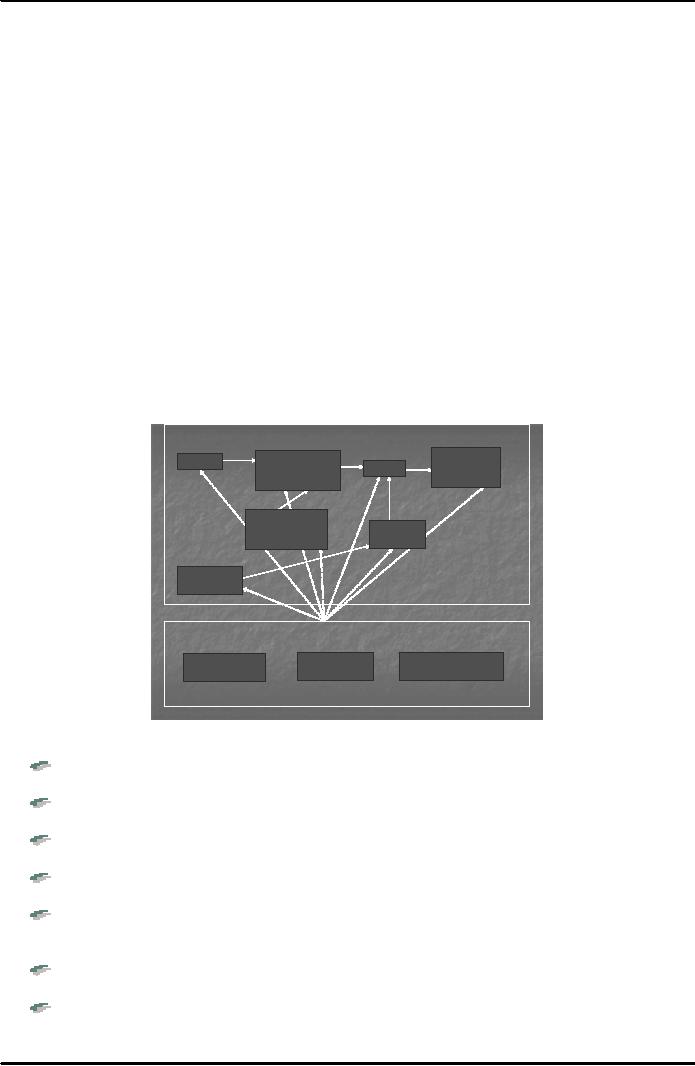 |
PERSONAL FINANCE ONLINE |
| << ELECTRONIC DATA INTERCHANGE (EDI) |
| SUPPLY CHAIN >> |

E-COMMERCE
IT430
VU
Lesson
37
PERSONAL
FINANCE ONLINE
Personal
finance allows the management of your
financial matters in a customized manner.
For example,
tax
calculations or financial budgeting can be done
through personal finance
software. Popular software
packages
for personal finance are Quicken, MS
Money and Money 2003
etc. In personal finance online
data
is
imported automatically into the register
of transactions maintained by the software
package as the
account/transaction
details are downloaded through the
internet. This information
can then
systematically
be
used to calculate taxes or
prepare a budget for certain
activities.
Value
Chain
EC
includes so many activities that it is
difficult to figure out
where and how to use it in
the business. One
way to
overcome this difficulty is to break
business into many value
adding activities. A strategic
business
unit
is a combination of a particular product,
distribution channel and
customer type. In 1985
Michael
Porter
gave the idea of value
chains in his famous book
"Competitive advantage". A value
chain is a way of
organizing
activities that each strategic
business unit undertakes to
design, produce, promote,
market,
deliver
and support the products or services it
sells.
Primary
and Support activities
Porter
identified that there are
some primary activities as well as
certain supporting activities in a
strategic
business
unit. Following is the example of
value chain for a strategic
business unit (see
Fig. 1 below):
Primary
activities
Provide
after
Manufacture
Design
sale
service
Deliver
product or
create
and
support
service
Purchase
Market
materials
and
and
sell
supplies
Identify
customers
Support
activities
Human
Technology
Finance
and
resources
development
administration
Fig.
1
`Identify
customers' refer to those activities
which try to find new
customers and ways to
serve
better to the
existing ones, e.g, surveys
and market research;
`Design'
activities take a product form
concept stage to manufacturing stage.
They include concept
research,
engineering, drawings preparation, test
marketing etc.
`Purchase
materials and supplies'
activities relate to procurement of
material, vendor
selection/qualification,
negotiating supply contracts, monitoring
quality and timely delivery
etc.
`Manufacture
product or create service' activities
relate to transformation of materials
and labor
into
finished products, e.g, fabricating,
assembling, packaging
etc.
`Market
and sell' activities give buyers a
way to purchase and provide
inducement for them to do
so,
e.g, advertising, promotions,
managing salespersons, monitoring
distribution channel,
pricing
etc.
`Deliver'
activities relate to storage,
distribution and shipment of final
product, e.g,
warehousing,
selecting
shippers, material handling, timely
delivery to customers etc.
`Provide after
sales service and support'
refer to those activities that aim at
promoting a continuing
relationship
with customers, e.g, installing,
testing, repairing, maintaining a
product, fulfilling
warranties
etc.
152

E-COMMERCE
IT430
VU
Note
that left to right flow
does not mean a strict time
sequence for these
activities. For
example,
marketing
activity can take place
before purchasing materials.
Importance
of each primary activity depends on the
product/service and the type of
customers.
For
example, for certain type of
businesses/products manufacturing activities
are more critical and
for
others marketing activities may be more
important.
Support activities
provide infrastructure for a business
unit's primary activities as indicated in Fig.
1
above.
Following are the support
activities:
`Finance
and administration' activities relate to
accounting, paying bills, borrowing funds
and
complying
with government regulations
etc.
`Human
resources' refer to the activities that coordinate
management of employees, e.g,
recruiting,
hiring,
compensation and benefits
etc.
`Technology
development' relates to activities which
help improve product/service
that a business
is
selling and also help
improve processes in every primary
activity, e.g, fields tests,
maintenance of
procedures,
process improvement studies
etc.
Industry
value chains
It is
useful to examine where a
strategic business unit fits
within its industry. Porter uses the term
value
system
to describe larger stream of activities
into which a business unit's
value chain is embedded.
Different
strategic
business units are associated,
each having its value chain,
to form industry value
chain. By
understanding
how other business units in industry
value chain conduct their
activities, mangers can
identify
new
opportunities for cost
reduction and product improvement.
Fig.
2 below shows industry
value
chain
of wooden furniture:
Logger
cuts down tree
Sawmill
converse logs to
lumber
Lumberyard
(distributor) provides
lumber
furniture
factory manufactures/assembles
Furniture
retailer markets and sells
furniture
Consumer
purchases and uses
furniture
disposes of
furniture which is
recycled
Fig.
2
Note
that loggers grow and
cut the trees to convert them
into logs. Sawmill purchases
logs and processes
them in
its processing unit to
converts them to lumbers. The lumberyard
business purchases lumbers
form
the
sawmill business and sells
them to furniture factory, which
manufactures furniture using the
lumbers.
Furniture
retailer buys the furniture from
furniture factory and sells it to
customers, who use it.
After
sometime
the furniture is of no use and is
disposed of by the customer. It can be
then recycled. Note
that
each
business unit has its
own value chain. The
analysis of industry value chain is
useful for a sawmill
business
that is considering entering the tree
harvesting/growing business or for
furniture retailer who
wants
to be a partner with a transportation
business. Industry value
chain identifies opportunities up
and
down
the product' s life cycle
for increasing efficiency or the quality
of product.
Examining
value chains one finds
that EC can help in four
different ways as
follows:
It can
reduce costs of a
business;
It can
improve quality of
products;
153

E-COMMERCE
IT430
VU
It can
help in reaching new
customers or suppliers;
It can
create new ways of selling
products.
For
example, a software developer who
releases annual updates of
his software might consider
eliminating
software
retailer from distribution channel
for updates by offering to
send updates through
internet directly
to his
customers. In this way he can
reduce the price of his
product and increase sales
revenue since revenue
margin
payable to the retailer can now be
cut down from the
price.
SWOT
(strengths, weaknesses, opportunities and
threats) analysis
In
SWOT analysis, an analyst
first looks into the business
unit to identify its
strengths and weaknesses
then
looks
into the environment in which the
business operates and identifies
opportunities and
threats
presented
by such environment.
While
judging the strengths of a business,
questions can be asked such
as what does a business do
well?.
Does
it have a sense of purpose
and culture to support that
purpose? While judging
weaknesses of a
business
questions can be asked as to what
does a company do poorly?. Has it
any serious financial
liabilities?.
Has it got the required skilled manpower?
In analyzing opportunities a company
can try to find
answers
to questions, such as, what is the
industry trend? Are there
any new markets to
enter/explore? Are
there
any new technologies to
use?. In finding threats to a
company's business it can
ask questions as to
what things the
competitors of the business doing better?
Are there any troublesome
changes in company's
business
environment? Are there any
new technologies or laws
likely to be introduced that
might cause
problem
to the company?
Example
of Dell
Dell,
a famous computer manufacturing brand, used
SWOT analysis in mid 1990s
to create a strong
business
strategy that made it a
successful competitor in its industry
value chain. It found that
its strength
was to
sell directly to customers
and design its computers to
reduce manufacturing costs. It also
found that
it had
no relation with local computer
dealers. It faced threats
from competitors which had
much stronger
brand names/quality
at that time. Dell identified an
opportunity by noting that
its customers were
becoming
more
knowledgeable about computers and could
specify what they wanted to buy
without Dell sales
person
helping
them or answering their questions to
develop configuration for them.
Moreover, it decided to
use
internet
as a potential marketing tool.
Dell
took all four SWOT
elements into consideration (see Fig. 3
below) and decided to offer
customized
computers.
The computers could be built/configured
according to the order or specifications
of the
customers
who could place orders
through phone and internet.
Thus, it developed a strategy using
its
strengths
effectively and avoiding
reliance on dealer network.
Note that brand and quality
threats form
competitors
were reduced in this case by
Dell's ability to deliver higher
perceived quality of its
product in
the
sense that each computer could be
customized according to the
needs/specifications of the
customers.
Strengths
Weaknesses
∑ sell
directly to consumers
∑ No strong
relationships
∑ keep
costs below
competitor's
with
computer dealers
costs
Threats
Opportunities
∑ Competitors
have stronger
∑ Consumers
know what they
brand
names
want to
buy
∑ Competitors
have strong
∑ Internet
could be a powerful
relationships
with computer
marketing
tool
dealers
Fig.
3
154
Table of Contents:
- E-COMMERCE
- WHAT IS A NETWORK
- HOW MANY CLASS A, B, C NETWORKS AND HOSTS ARE POSSIBLE
- NETWORKING DEVICES
- BASICS OF HTML 1
- BASICS OF HTML 2
- TEXT BOXES, CHECK BOXES, RADIO BUTTONS
- FRAMES AND IMAGES IN HTML
- TAG ATTRIBUTES, SOUNDS FILES, ANIMATIONS
- STYLE SHEETS 1
- STYLE SHEETS 2
- SOME USEFUL STYLE SHEETS PROPERTIES
- JAVA SCRIPTING 1
- JAVA SCRIPTING 2
- JAVA SCRIPTING 3
- JAVA SCRIPTING AND XML
- CLIENT AND SERVER SIDE PROCESSING OF DATA
- APPLETS, CGI SCRIPTS
- MAINTAINING STATE IN A STATELESS SYSTEM
- INTEGRATION WITH ERP SYSTEMS
- FIREWALLS
- CRYPTOGRAPHY
- HASH FUNCTION AND MESSAGE DIGEST
- SYMMETRIC KEY ALGORITHMS
- VIRTUAL PIN PAYMENT SYSTEM
- E-CASH PAYMENT SYSTEM 1
- E-CASH PAYMENT SYSTEM 2
- SECURE SOCKET LAYER (SSL)
- E-BUSINESS: DISADVANTAGES OF E-BUSINESS
- E-BUSINESS REVENUE MODELS
- E-MAIL MARKETING
- CUSTOMER RELATIONSHIP MANAGEMENT (CRM)
- META INFORMATION
- DATA MINING
- CONFIDENCE AND SUPPORT
- ELECTRONIC DATA INTERCHANGE (EDI)
- PERSONAL FINANCE ONLINE
- SUPPLY CHAIN
- PORTERíS MODEL OF COMPETITIVE RIVALRY
- BARRIERS TO INTERNATIONAL E-COMMERCE
- ELECTRONIC TRANSACTIONS ORDINANCE, 2002 - 1
- ELECTRONIC TRANSACTIONS ORDINANCE, 2002 - 2
- ELECTRONIC TRANSACTIONS ORDINANCE, 2002 - 3
- GLOBAL LEGAL ISSUES OF E-COMMERCE - 1
- GLOBAL LEGAL ISSUES OF E-COMMERCE - 2